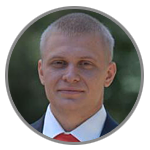As part of our “Who’s Who” column, we talked with the executive director of Crystal Clear Soft studio Bogdan Nesvit about the history of the studio itself and how its work is structured.

Hi. Tell me first about how the history of the studio began?
Bogdan Nesvit
Hi. It all started in the 2000s. We were ordinary guys who loved to play games, and also loved computers and everything related to them. I got my first experience of game development as a beta tester at Meridian93 back on the border of millennia, where we developed projects for PC.
Later, cooperation with them ceased. After that, I spent some time working with friends on online projects. It was at this time that Crystal Clear Soft was founded by Mikhail from Kharkov. A little later I joined him.
Of course, we met him even before that – at the university, where we studied programming together. We also played Counter-Strike together, were professional cyber-athletes.
At Crystal Clear Soft, we started not with games, but with the creation of web portals, copyright, rewriting and unifying texts, seo promotion. In those years, it was the quality of writing code that was valued, there were not so many strong programmers, so it was decided that the company would be called Crystal Clear Soft. A little later, in addition to the web, we began to engage in games: we did both outsourcing projects and our own. The company initially worked not purely according to the outsourcing scheme, but according to a mixed one: we had both outsourcing and our own projects. That’s how we’ve been working for the second decade. We have always had different sources of financing: outsourcing, our own projects, partner development and third-party investments in individual projects, and all this in parallel.
Which project was the studio’s first really major success?
The company’s first success in those years was a number of very successful web portals. And in games, the first really profitable projects for us were casinos and slots. We also believe that people began to find us themselves and wanted to order development from us. It was very pleasant and unexpected.
How did you consolidate success?
Success was consolidated by increasing the types of activities.
At the moment, our structure is as follows: there is a separate partner company Code IT, which is exclusively engaged in b2b outsourcing development with a focus on Western partners; and there is a company Crystal Clear Soft, which is partially engaged in outsourcing game development, but also actively develops the development of its own projects.
Game projects are divided into a casual direction and a midcore-hardcore direction. Thus, we cover almost all the main niches.
By the way, once we started talking about autosource. What pitfalls of this type of business would you note?
This is a very difficult business, in which everything is built on pitfalls. The main thing here is to find a common language with the client, because without this nothing will work.
It doesn’t matter if you have small (keyword) problems in outsourcing development or not, if you have found a common language with the client, then your development will be successful. And if a common language is not found, then it will be quite difficult to achieve a general positive result.
In general, as a company, we actively strive for partner projects, because they are more profitable for all parties to cooperation. From this point of view, outsourcing works just fine. In practice, it looks like this: we do outsourcing work for a future partner, and if he likes everything, then we already start partner projects. In fact, outsourcing is both a test of us and a test of our partner. He looks at how we work, and we look at how he works. Everyone draws conclusions for themselves, develops a suitable scheme of cooperation. And if we find many common points for work, then outsourcing work becomes the foundation for long-term pleasant and profitable partnerships.
And how is the work of the company itself structured?
We constantly have internal processes for optimizing the entire work of the company. There is a group of people who are engaged in this, but also all the specialists of the company are involved in this process. The essence of the work is that we are constantly studying new technologies and the possibility of their application in development. We are constantly working on standardization of work processes and improving them. We develop and apply our own technological solutions. We try to standardize all our activities as much as possible, to bring it to a common denominator as much as possible.
We pay great attention to workflow automation. This is generally a separate topic that is important to develop. A lot of workflows are identical, and if you learn how to properly automate them, you will save a lot of time. It is also very important to understand all these points. That is, roughly speaking, you can’t automate something if you don’t understand what exactly is needed and can be automated. If you see these bottlenecks, you are already 50% closer to the right solution. This is an endless process, which in duration should be equal to the time of the company’s existence.
We are constantly working to analyze our activities, to identify bottlenecks in development, in management. We are changing, adapting to modern trends and requirements, moving away from old methodologies and tools. If we clearly understand that standard solutions are needed and they will be more effective, then we follow them. And if we see that they do not work, then we modernize them to suit our own needs and conditions. Even top management does not have an extra Ego in the form of blind attachment to the usual methods of work. If conditions require it, we revise our principles and postulates, corporate requirements, changing them.
Many people do not understand that modern game development is a tough business, so you need to be very flexible to survive in it. And this necessary flexibility is achieved only by building all the work according to the optimal ways for your company. That is, you have to take into account all your pros and cons in order to make a final decision and move in some direction. And it’s quite difficult. Many people do not want to change, they are not ready to develop, reaching a certain level.
But I think this does not apply to our team, because we improve the skills of employees, increase their involvement not only in their own tasks, but also in the tasks facing the whole company. As a manager, I am very pleased to observe my team. I see that each person develops individually. I like to analyze the growth of employees, to see how high-level specialists grow from former juniors. Now many of these people are tied to important development processes, they have become our foundation. And I am proud of my team, which has been raising the overall bar of our projects for a long period, gaining experience and becoming even more professional. We are growing together, and I hope we will continue to develop as a single friendly team. The overall level of the tasks we solve is growing from year to year. We have gone through several important and difficult stages, crises. And this means that, in general, the vector of development is correct. And I am grateful to our entire team, each member of which contributes to the overall success.
It is important that when we start cooperating with new partners, they are often satisfied with the quality of the work performed. But we work with very large and well-known companies. Their feedback is an important indicator that we are not working in vain.
And the last question: what kind of activity (development / websites / graphic design) is the most profitable for the company now?
In general, outsourcing development and in-house projects are the most profitable. But we try to focus on our own development, because we understand that earnings on outsourcing are momentary and limited. In this area, you earn here and now, and the bar for this earnings is always fixed by your agreements with the customer. As for your own projects, the earnings bar in them depends solely on yourself and the success of the product. That is, the potential in this area is higher.
I see. Thanks for the interview!

